Hyper Crazy Climber
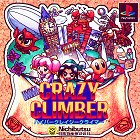 The Game: You’re crazy-climbing the inner city no more. As one of a party of three adventurers, your mission is to scale mystic mountain peaks, Big Ben-style clock towers, and even enormous beanstalks, all to gather various items and move on to the next stop on your quest. Obstacles such as an avalanche of killer boulders and monkeys tossing bananas at you could send you plummeting to your death. The three characters along for the adventure have different rates of speed and endurance (as in endurance for things falling on their heads, though nothing will save you from a huge boulder). Watch out for falling rocks! (Nichibutsu, 1996)
The Game: You’re crazy-climbing the inner city no more. As one of a party of three adventurers, your mission is to scale mystic mountain peaks, Big Ben-style clock towers, and even enormous beanstalks, all to gather various items and move on to the next stop on your quest. Obstacles such as an avalanche of killer boulders and monkeys tossing bananas at you could send you plummeting to your death. The three characters along for the adventure have different rates of speed and endurance (as in endurance for things falling on their heads, though nothing will save you from a huge boulder). Watch out for falling rocks! (Nichibutsu, 1996)
Memories: This is one fiendishly difficult game. Normally, when I put together a Phosphor Dot Fossil, I play to get as far as I can in the game so you can get a glimpse of as many levels as possible. Not everyone reading this has all of these games, so I try to show you everything that I can.
Star Wars: Dark Forces
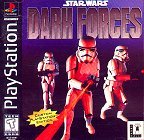
 The Game: Former Imperial officer Kyle Katarn has defected and joined the Rebel Alliance – and they intend to use him as an undercover operative. With his knowledge of infiltration and Imperial procedures, Katarn is the perfect choice to wreak havoc from the inside. But getting back in to an Imperial facility is the trick isn’t it? And it’ll cost you a little something extra – namely, a lot of pain, and a lot of time spent hiding, running, and blasting away at hordes of stormtroopers and a few other enemies, including bounty hunters Boba Fett and Bossk. If you can help Katarn survive long enough, he may discover the secret of the Empire’s legion of darktroopers, a new breed of stormtrooper with more advanced weaponry and almost invincible armor. (LucasArts, 1995)
The Game: Former Imperial officer Kyle Katarn has defected and joined the Rebel Alliance – and they intend to use him as an undercover operative. With his knowledge of infiltration and Imperial procedures, Katarn is the perfect choice to wreak havoc from the inside. But getting back in to an Imperial facility is the trick isn’t it? And it’ll cost you a little something extra – namely, a lot of pain, and a lot of time spent hiding, running, and blasting away at hordes of stormtroopers and a few other enemies, including bounty hunters Boba Fett and Bossk. If you can help Katarn survive long enough, he may discover the secret of the Empire’s legion of darktroopers, a new breed of stormtrooper with more advanced weaponry and almost invincible armor. (LucasArts, 1995)
Memories: Though clearly inspired by the Doom / Duke Nukem genre of first person shooters, Dark Forces won many a fan simply by virtue of being a Star Wars game that doesn’t involve spaceflight.
Pepenga Pengo
 The Game: Pengo the penguin is trapped in an ice maze with seals, walking snowmen and other predators. Pengo can defeat his enemies by pushing ice blocks toward them, crushing them in the process. Pengo can also create new ice blocks via some biological process that’s perhaps best left unexplored (and if he doesn’t leave the spot where he generates ice blocks immediately after starting that process, he’ll be temporarily frozen to that spot); those blocks can also become ammo in a pinch. Treats such as dollar signs and popsicles – both valuable commidities to penguins – appear from time to time. Defeating all enemies on a given level advances Pengo to the next screen. (Sega, 1995, for Japanese market only)
The Game: Pengo the penguin is trapped in an ice maze with seals, walking snowmen and other predators. Pengo can defeat his enemies by pushing ice blocks toward them, crushing them in the process. Pengo can also create new ice blocks via some biological process that’s perhaps best left unexplored (and if he doesn’t leave the spot where he generates ice blocks immediately after starting that process, he’ll be temporarily frozen to that spot); those blocks can also become ammo in a pinch. Treats such as dollar signs and popsicles – both valuable commidities to penguins – appear from time to time. Defeating all enemies on a given level advances Pengo to the next screen. (Sega, 1995, for Japanese market only)
Memories: Released only for the Sega Mega Drive (the Japanese equivalent of the Genesis console), Pepenga Pengo is a nice update of the original, not only enhancing the graphics but including new game play elements that don’t “break the universe” of the original.
Namco Museum Volume 2 (Japanese version)
 The Game: Old games never die – they get emulated. Fortunately, one of Japan’s greatest makers of video game hits has built a museum around several of its most popular titles. With Pac-Man still underfoot, you wander the corridors of the Namco Museum yet again. (Namco, 1995, for Sony Playstation)
The Game: Old games never die – they get emulated. Fortunately, one of Japan’s greatest makers of video game hits has built a museum around several of its most popular titles. With Pac-Man still underfoot, you wander the corridors of the Namco Museum yet again. (Namco, 1995, for Sony Playstation)
Memories: It’s hard for me to really justify blowing $25 on this particular import. Maybe it’s just the perversity of having two different versions of Namco Museum Vol. 2 when the American edition is hard enough to find as it is. Or maybe it’s because I want to be able to play as many classic arcade games as possible on my Playstation.
Namco Museum Volume 3 (“M”)
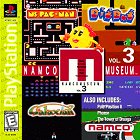
 The Game: Old games never die – they get emulated and encased in digital museums. Some game companies, like Namco, are big enough to spread their best titles out over five discs. With Pac-Man hanging around, you wander the corridors of the Namco Museum once more. (Namco, 1995)
The Game: Old games never die – they get emulated and encased in digital museums. Some game companies, like Namco, are big enough to spread their best titles out over five discs. With Pac-Man hanging around, you wander the corridors of the Namco Museum once more. (Namco, 1995)
Memories: Namco Museum 3, reprinted in the “greatest hits” range of Playstation games, contains some of the biggest coin-op successes to emerge from Japan’s video game supergiant – but this volume, also known early on as “Volume M,” also sees the beginning of the Namco Museum collection’s shift toward fighting and action-RPG-style games.
Galaxian3
 The Game: An alien war fleet is closing in on Earth, armed with a powerful weapon that can eradicate the entire planet. You (and, if you happen to have some fellow gunners, four others) man the artillery batteries of an armed-to-the-teeth ship on a mission to take the fight to the aliens before they can bring it to Earth. If you successfully complete that mission, you can also move on to a second mission to defend the planet Gourb from the Galaxian fleet. (Namco, 1995)
The Game: An alien war fleet is closing in on Earth, armed with a powerful weapon that can eradicate the entire planet. You (and, if you happen to have some fellow gunners, four others) man the artillery batteries of an armed-to-the-teeth ship on a mission to take the fight to the aliens before they can bring it to Earth. If you successfully complete that mission, you can also move on to a second mission to defend the planet Gourb from the Galaxian fleet. (Namco, 1995)
Memories: This is the home adaptation of Namco’s theatrical walk-in video experience which appeared in arcades and amusement centers around 1990. How theatrical is it? The game’s literally in widescreen, with scoring information and statistics appearing outside of the letterbox area.
Star Trek: The Next Generation
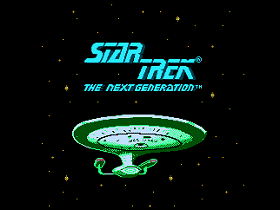 The Game: Captain Picard puts you in charge of a simulated mission aboard the Enterprise. With the helpful advice of Commander Riker, Data, Geordi, Worf and Chief O’Brien, you have to command the pride of the Federation fleet into a number of difficult situations, accomplish as much of the mission objectives as you can, and bring the Enterprise home in one piece. (Absolute, 1993)
The Game: Captain Picard puts you in charge of a simulated mission aboard the Enterprise. With the helpful advice of Commander Riker, Data, Geordi, Worf and Chief O’Brien, you have to command the pride of the Federation fleet into a number of difficult situations, accomplish as much of the mission objectives as you can, and bring the Enterprise home in one piece. (Absolute, 1993)
Memories: It’s funny how so many of the Star Trek games I actually like can actually be traced back to Sega’s 1982 Star Trek: Strategic Operations Simulator arcade game. Though Star Trek: The Next Generation tacks on a bunch of bells and whistles, such as consulting the bridge crew about the situation (how Picard 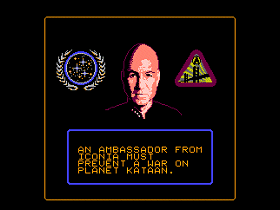 is that?) and having to go to their screens to kick in things like the shields, weapons and warp drive, when it comes right down to it, if you strip away these elements, it’s the same basic game: you’re blasting away at enemy ships and hoping to get more clean shots in at them then they get at you. He whose shields fail first gets blown out of the sky. In 11 years, the basic Star Trek game hadn’t evolved that much (but at least The Next Generation doesn’t get the torturously slow “story” scenes of Star Trek: 25th Anniversary).
is that?) and having to go to their screens to kick in things like the shields, weapons and warp drive, when it comes right down to it, if you strip away these elements, it’s the same basic game: you’re blasting away at enemy ships and hoping to get more clean shots in at them then they get at you. He whose shields fail first gets blown out of the sky. In 11 years, the basic Star Trek game hadn’t evolved that much (but at least The Next Generation doesn’t get the torturously slow “story” scenes of Star Trek: 25th Anniversary).
Super Mario Kart
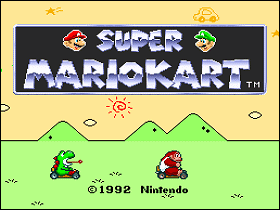 The Game: It’s a big day at the races, with a field of drivers selected from the Mushroom Kingdom: Mario, Luigi, Princess Peach, Toad, Bowser, and even Donkey Kong Jr. are among the racers vying for the top spot. From the grassy Mushroom course to the punishingly muddy Star course to the oceanside Flower course, there are challenges, hairpin turns and obstacles. Whoever can learn to navigate each course the fastest without ending up out of bounds struggling to get back on the course will be the winner. (Nintendo, 1992)
The Game: It’s a big day at the races, with a field of drivers selected from the Mushroom Kingdom: Mario, Luigi, Princess Peach, Toad, Bowser, and even Donkey Kong Jr. are among the racers vying for the top spot. From the grassy Mushroom course to the punishingly muddy Star course to the oceanside Flower course, there are challenges, hairpin turns and obstacles. Whoever can learn to navigate each course the fastest without ending up out of bounds struggling to get back on the course will be the winner. (Nintendo, 1992)
Memories: At a time when Nintendo could’ve been accused of returning to the well too many times for Super Mario, they instead took a racing game and populated it with a cast from the Mario mythos. The characters are more or less incidental to the game, mere window dressing that was actually added months into the development cycle of a game that started off without them – but it was clearly a shrewd marketing move to include them, as Super Mario Kart became one of the SNES‘ most-loved games.
Q*Bert 3
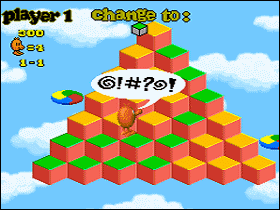 The Game: Q*Bert, a nosey little guy with a propensity for hopping, spends his time hopping around a three-dimensional pyramid of cubes, avoiding Coily the Snake and other assorted purple and red creatures, including a few who operate on a slightly different plane (i.e., they move down the pyramid as if it were rotated one-third). Changing the colors of the top of every cube in the pyramid to the target color indicated at the top left of the screen will clear the pyramid and start the craziness all over again. If Q*Bert is hit by an enemy or falls off the pyramid, he hits bottom with a resounding, arcade- cabinet-shaking splat and a burst of incomprehensible obscenity! (NTVIC, 1992)
The Game: Q*Bert, a nosey little guy with a propensity for hopping, spends his time hopping around a three-dimensional pyramid of cubes, avoiding Coily the Snake and other assorted purple and red creatures, including a few who operate on a slightly different plane (i.e., they move down the pyramid as if it were rotated one-third). Changing the colors of the top of every cube in the pyramid to the target color indicated at the top left of the screen will clear the pyramid and start the craziness all over again. If Q*Bert is hit by an enemy or falls off the pyramid, he hits bottom with a resounding, arcade- cabinet-shaking splat and a burst of incomprehensible obscenity! (NTVIC, 1992)
Memories: Released a full decade after the original game, Q*Bert 3 for the SNES seems to draw its inspiration in equal measure from the 1982 arcade classic and the Game Boy version by Jaleco, which broke the arcade game’s “pyramid of cubes” mold and brought newer, more challenging shapes to the table to confound long-timers who thought they had the game licked.
Klax
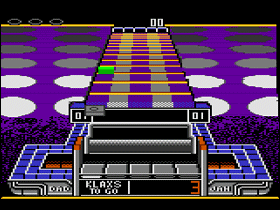 The Game: It is the nineties, as the intro screen says, and there is time for this home version of Klax, in which players try to stack colored bricks according to on-screen instructions: horizontal, vertical and diagonal rows may be required. The conveyor belts carrying the bricks gradually speed up until the bricks are zipping toward the bottom of the screen at a dizzying pace. Allowing too many bricks to slide off the bottom of the screen without catching them will forfeit the game, as will failing to come up with the configuration of stacked bricks demanded by the on-screen instructions. (Atari, 1990)
The Game: It is the nineties, as the intro screen says, and there is time for this home version of Klax, in which players try to stack colored bricks according to on-screen instructions: horizontal, vertical and diagonal rows may be required. The conveyor belts carrying the bricks gradually speed up until the bricks are zipping toward the bottom of the screen at a dizzying pace. Allowing too many bricks to slide off the bottom of the screen without catching them will forfeit the game, as will failing to come up with the configuration of stacked bricks demanded by the on-screen instructions. (Atari, 1990)
Memories: A late attempt to keep the Atari 7800 relevant in an age where the NES had firmly dominated the home video game landscape (even the Sega Master System enjoyed a larger market share than the 7800), this adaptation of Atari Games’ arcade sleeper hit Klax seems fitting somehow in retrospect: Klax was a puzzle game also-ran, trying to catch up with Tetris. And Tetris had already been snapped up by Nintendo, which was handily beating Atari with both the NES and the new Game Boy, making the 7800 an also-ran too (and let’s not talk about that whole dust-up over Atari Games’ arcade Tetris and the Tengen version of the game for NES). As if there needed to be a way to make Klax even less relevant in Atari’s fight against Tetris, there’s one more wrinkle: this version never actually hit the stores.
SimCity
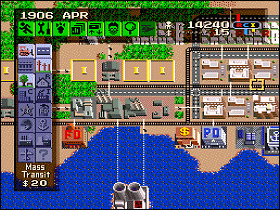 The Game: Players start with a blank slate of a land mass, a budget, and their hopes and dreams. The building of a city begins (usually with a power plant of some kind), a delicate attempt to balance residential, commercial, and industrial space, transportation systems, demands from the public, and tax rates. The city will flourish, stagnate, or empty out and completely fail depending upon the player’s mayoral choices. (Nintendo/Maxis, 1991)
The Game: Players start with a blank slate of a land mass, a budget, and their hopes and dreams. The building of a city begins (usually with a power plant of some kind), a delicate attempt to balance residential, commercial, and industrial space, transportation systems, demands from the public, and tax rates. The city will flourish, stagnate, or empty out and completely fail depending upon the player’s mayoral choices. (Nintendo/Maxis, 1991)
Memories: SimCity started out as a computer game, with all that implies – mouse control, keystroke commands, and complexity that shouldn’t be that easy to boil down into console form. This console port for the SNES, published just a few years after the original DOS PC game’s popularity explosion, is more faithful to its source material than anyone had any reasonable chance to expect.
Ultima: Quest Of The Avatar
![]() The Game: Darkness has fallen anew upon Britannia, and Lord British calls for your service again. You start out alone, accumulating traveling (and fighting) companions along your journey, striving to live by the Eight Virtues that govern conduct in the kingdom. Along the way, numerous creatures, both evil and simply pesky, challenge you. As you go forth on the quest, you must also collect the mantras of each Virtue, travel to the corresponding Shrines, and meditate there until you reach enlightenment. With enlightenment and experience come the strength to rid Britannia of evil – but, to quote a little pointy-eared green guy, beware the dark side… (FCI / Pony Canyon, 1990)
The Game: Darkness has fallen anew upon Britannia, and Lord British calls for your service again. You start out alone, accumulating traveling (and fighting) companions along your journey, striving to live by the Eight Virtues that govern conduct in the kingdom. Along the way, numerous creatures, both evil and simply pesky, challenge you. As you go forth on the quest, you must also collect the mantras of each Virtue, travel to the corresponding Shrines, and meditate there until you reach enlightenment. With enlightenment and experience come the strength to rid Britannia of evil – but, to quote a little pointy-eared green guy, beware the dark side… (FCI / Pony Canyon, 1990)
Memories: Where the NES edition of the third Ultima game took place in a compressed version of the original computer game’s expansive world. If the map of the world of Sosaria from the Apple II version of Exodus: Ultima III was printed on one of those squishy little stress balls, the NES version was what you’d see if the ball was squeezed: all the continents, while vaguely similar, were suddenly jammed up against each other. Ultima IV‘s even larger map is surprisingly intact on the NES.
Qix
 The Game: You are a marker, trying to claim as much of the playing field as you can by enclosing areas of it. Drawing your boundaries faster is safer, but yields fewer points. A slower draw, which leaves you vulnerable to attack from the Qix and the Sparx, gives you many more points upon the completion of an enclosed area. If the ever-shifting Qix touches your marker or an uncompleted boundary you are drawing, you lose a “life” and start again. And the Sparx, which travel only along the edges of the playing field and along the boundaries of areas of the screen you’ve already enclosed, can destroy you by touching your marker. And if you linger too long, a fuse will begin burning at the beginning of your unfinished boundary, and will eventually catch up with you. (Nintendo/Taito, 1990)
The Game: You are a marker, trying to claim as much of the playing field as you can by enclosing areas of it. Drawing your boundaries faster is safer, but yields fewer points. A slower draw, which leaves you vulnerable to attack from the Qix and the Sparx, gives you many more points upon the completion of an enclosed area. If the ever-shifting Qix touches your marker or an uncompleted boundary you are drawing, you lose a “life” and start again. And the Sparx, which travel only along the edges of the playing field and along the boundaries of areas of the screen you’ve already enclosed, can destroy you by touching your marker. And if you linger too long, a fuse will begin burning at the beginning of your unfinished boundary, and will eventually catch up with you. (Nintendo/Taito, 1990)
Memories: One of the few completely abstract arcade games ever to catch on with the public, Qix is very hard to get wrong, and this adaptation – an early first-party Game Boy cartridge patterned after a similarly first-person NES version – certainly doesn’t get it wrong. It’s pure Qix, without any added bull about having to uncover a picture by claiming area on the playfield.
Pac-Mania
 The Game: As a round yellow creature consisting of a mouth and nothing else, you maneuver around relatively simple mazes, gobbling small dots and evading five colorful monsters who can eat you on contact. In four corners of the screen, larger dots enable you to turn the tables and eat the monsters for a brief period. Periodically, assorted items appear near the center of the maze, and you can consume these for additional points as well. The monsters, once eaten, return to their home base in ghost form and return to chase you anew. If you clear the maze of dots, you advance to a new maze and the game starts again, but just a little bit faster… (Tengen, 1990)
The Game: As a round yellow creature consisting of a mouth and nothing else, you maneuver around relatively simple mazes, gobbling small dots and evading five colorful monsters who can eat you on contact. In four corners of the screen, larger dots enable you to turn the tables and eat the monsters for a brief period. Periodically, assorted items appear near the center of the maze, and you can consume these for additional points as well. The monsters, once eaten, return to their home base in ghost form and return to chase you anew. If you clear the maze of dots, you advance to a new maze and the game starts again, but just a little bit faster… (Tengen, 1990)
Memories: Having watched its own home video game unit fall into obsolescence with the rise of the Nintendo Entertainment System, Atari Games – the original Atari’s arcade division, spun off into its own entity after the Tramiel family split the company – quietly started a new subsidiary to begin mining the NES market. This new division, Tengen, produced only a few games – and in so doing, wound up in big trouble with Nintendo.
Dr. Mario
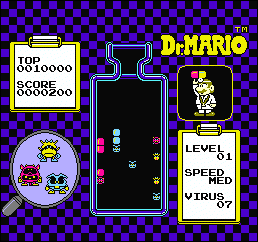 The Game: Now that he’s got plumbing and rescuing princesses out of the way, Mario ‘s gone and finished his medical degree. You have to help him dish out just the right pills to get rid of the corresponding viruses, matching them by color. Stacking at least three pill segments of the same color on top of or next to a virus will kill it, but the leftover pill segments will fall into place, possibly keeping you from treating other problems. (Mismatched pills can be eliminated too, by creating a stack of four segments of the same color.) Allowing too many pills to clog the works will end the game. (Nintendo, 1990)
The Game: Now that he’s got plumbing and rescuing princesses out of the way, Mario ‘s gone and finished his medical degree. You have to help him dish out just the right pills to get rid of the corresponding viruses, matching them by color. Stacking at least three pill segments of the same color on top of or next to a virus will kill it, but the leftover pill segments will fall into place, possibly keeping you from treating other problems. (Mismatched pills can be eliminated too, by creating a stack of four segments of the same color.) Allowing too many pills to clog the works will end the game. (Nintendo, 1990)
Memories: Okay, it’s no Microsurgeon (and it’s no Tetris either), but there’s something addictive about whatever pills Mario was prescribing during his brief medical career.
Super Mario Land
 The Game: As intrepid plumber (and explorer) Mario, players have to jump through new environments and enemies to help Mario rescue Daisy. Egyptian pyramids guarded by fire-breathing Sphinxes, seaside platforms invaded by space aliens, and the usual Goombas and Koopas await Mario as he tries to reach the end of each level. As always, there are mushrooms, stars and fire flowers to help Mario power up, and helpful hidden chambers full of coins. (Nintendo, 1989)
The Game: As intrepid plumber (and explorer) Mario, players have to jump through new environments and enemies to help Mario rescue Daisy. Egyptian pyramids guarded by fire-breathing Sphinxes, seaside platforms invaded by space aliens, and the usual Goombas and Koopas await Mario as he tries to reach the end of each level. As always, there are mushrooms, stars and fire flowers to help Mario power up, and helpful hidden chambers full of coins. (Nintendo, 1989)
Memories: One of the original Game Boy launch titles, Super Mario Land was almost the game that was included with the Game Boy itself. And why not? Super Mario Bros. and Super Mario Bros. 2 were certified smash hits with the same kind of household-name recognition that had once been the sole domain of Pac-Man.
Q*Bert
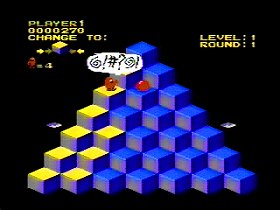 The Game: Q*Bert, a nosey little guy with a propensity for hopping, spends his time hopping around a three-dimensional pyramid of cubes, avoiding Coily the Snake and other assorted purple and red creatures, including a few who operate on a slightly different plane (i.e., they move down the pyramid as if it were rotated one-third). Any green objects and creatures Q*Bert can catch will not hurt him – in fact, the little bouncing green balls will stop time briefly for everyone but Q*Bert. If he gets into a tight spot, Q*Bert can jump off the pyramid onto a flying disc which will despoit him back at the top of the pyramid – and lure Coily to a nasty fate by jumping into nothing. Changing the colors of the top of every cube in the pyramid to the target color indicated at the top left of the screen will clear the pyramid and start the craziness all over again. If Q*Bert is hit by an enemy or falls off the pyramid, he hits bottom with a resounding, arcade- cabinet-shaking splat and a burst of incomprehensible obscenity! (Konami/Ultra, 1989)
The Game: Q*Bert, a nosey little guy with a propensity for hopping, spends his time hopping around a three-dimensional pyramid of cubes, avoiding Coily the Snake and other assorted purple and red creatures, including a few who operate on a slightly different plane (i.e., they move down the pyramid as if it were rotated one-third). Any green objects and creatures Q*Bert can catch will not hurt him – in fact, the little bouncing green balls will stop time briefly for everyone but Q*Bert. If he gets into a tight spot, Q*Bert can jump off the pyramid onto a flying disc which will despoit him back at the top of the pyramid – and lure Coily to a nasty fate by jumping into nothing. Changing the colors of the top of every cube in the pyramid to the target color indicated at the top left of the screen will clear the pyramid and start the craziness all over again. If Q*Bert is hit by an enemy or falls off the pyramid, he hits bottom with a resounding, arcade- cabinet-shaking splat and a burst of incomprehensible obscenity! (Konami/Ultra, 1989)
Memories: Ah, the eternal conundrum of Q*Bert – to turn the controller, or try to do diagonals with an NES joypad? The original arcade incarnation of the mighty orange one solved the problem pretty simply by turning a standard four-directional joystick at a 45-degree angle within the coin-op’s casing. To truly replicate that effect, you’re given the option of rotating the NES controller 45 degrees or to try to do diagonals while holding it straight (in effect, hitting the left and down portions of the plus-shaped pad simultaneously to move in that direction). There’s a whole pre-game startup screen devoted to controller orientation here. And as awkward as it is, the 45-degree angle option is much more responsive on the NES. Now, a joystick such as the Advantage may help here, but again, the hardware itself dictates that the controller won’t be as responsive diagonally.
Off The Wall
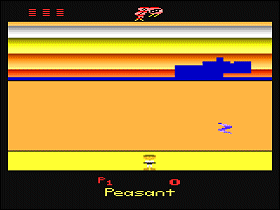 The Game: A worm-like dragon taunts you from atop a multi-colored wall, one which you must topple to reunite your divided village. To accomplish this task, you must bounce hurled projectiles into the wall. Collecting power-ups along the way will affect the behavior of the projectile, from making it a weapon capable of wiping out large portions of the wall to making it return to you repeatedly, like a boomerang. You advance to the next level by eliminating the wall. (Atari, 1989)
The Game: A worm-like dragon taunts you from atop a multi-colored wall, one which you must topple to reunite your divided village. To accomplish this task, you must bounce hurled projectiles into the wall. Collecting power-ups along the way will affect the behavior of the projectile, from making it a weapon capable of wiping out large portions of the wall to making it return to you repeatedly, like a boomerang. You advance to the next level by eliminating the wall. (Atari, 1989)
Memories: In the beginning, there was Breakout, a game which Atari itself cloned and put through endless permutations; even Warlords, a favorite among classic gamers everywhere, was a stepchild of Breakout and QuadraPong. Eventually, after turning out Breakout and its clones for the home video game market, Atari turned to other ideas. In the late 1980s, Taito unleashed Arkanoid – essentially an updated version of Breakout – and brought the breaking-down-brick-walls genre back into the public eye.
Baseball
 The Game: Baseball returns to the small screen – the very small screen – on the Game Boy. Step up to the plate and take a swing; after three outs, take control of the pitcher, basemen and outfield, trying to keep the computer from scoring a run. (Nintendo, 1989)
The Game: Baseball returns to the small screen – the very small screen – on the Game Boy. Step up to the plate and take a swing; after three outs, take control of the pitcher, basemen and outfield, trying to keep the computer from scoring a run. (Nintendo, 1989)
Memories: If Baseball! on the Odyssey2 was my favorite iteration of baseball as a video game during the 1980s, Nintendo‘s Baseball was my favorite of the late ’80s and ’90s. I remember spending a lot of quality time with this game on my first Game Boy – and most of that time was fun and challenging rather than frustrating, placing this well above quite a few baseball video games.
Star Wars
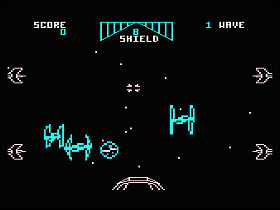 The Game: You’re an intrepid X-Wing pilot participating in the last-ditch Rebel attempt to destroy the Death Star – before it destroys the Rebel base on Yavin IV. TIE Fighters try to intercept you, but you can destroy them (as well as use your own lasers to blast their incoming fire out of the sky). Then you move in to attack the Death Star itself, with its incredibly hazardous system of gunnery towers and bunkers. Once you’ve gotten past the surface defenses, you dive into the trench that will lead you to an exhaust port which is the only means of destroying the Death Star – but there are defenses in the trench as well, and your deflector shields can only take so much… (Domark / Zeppelin Games Ltd., 1988)
The Game: You’re an intrepid X-Wing pilot participating in the last-ditch Rebel attempt to destroy the Death Star – before it destroys the Rebel base on Yavin IV. TIE Fighters try to intercept you, but you can destroy them (as well as use your own lasers to blast their incoming fire out of the sky). Then you move in to attack the Death Star itself, with its incredibly hazardous system of gunnery towers and bunkers. Once you’ve gotten past the surface defenses, you dive into the trench that will lead you to an exhaust port which is the only means of destroying the Death Star – but there are defenses in the trench as well, and your deflector shields can only take so much… (Domark / Zeppelin Games Ltd., 1988)
Memories: Years after Parker Brothers’ lumpen version of Atari’s Star Wars arcade game, someone finally had the decency to bring Atari’s hit game home to Atari’s home computers in a form that’s worth playing. And as luck would have it, North American Atari 8-bit owners didn’t get to see this one – it was a British exclusive release.
Xevious
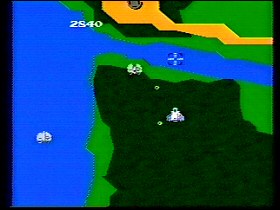 The Game: As the commander of a sleek Solvalou fighter, you’re deep into enemy territory, shooting their disc-shaped fighters out of the sky, bombing ground installations and artillery nests, bombing tanks, and trying to destroy the
The Game: As the commander of a sleek Solvalou fighter, you’re deep into enemy territory, shooting their disc-shaped fighters out of the sky, bombing ground installations and artillery nests, bombing tanks, and trying to destroy the  mothership. As you progress further behind enemy lines, heavier aircraft and more versatile and deadly ground-based defenses become the norm. Also look out for tumbling airborne mirrors – they’re impervious to your fire, but you’re toast if you fly right into them. (Bandai, 1988)
mothership. As you progress further behind enemy lines, heavier aircraft and more versatile and deadly ground-based defenses become the norm. Also look out for tumbling airborne mirrors – they’re impervious to your fire, but you’re toast if you fly right into them. (Bandai, 1988)
Memories: It wasn’t the first version of Xevious ever to hit a home console – Atari, who held the arcade rights for Namco’s genre-defining scrolling shoot ’em up in North America, made sure it had the rights for its home consoles too. But, in one of the more unfortunate coincidences of the video game industry, none of the three planned versions of Xevious made it out of the starting gate on time.
Mappy Land
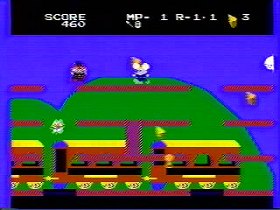 The Game: Mappy the Mouse is back, pursuing his feline arch nemesis Boss The Big Bit and his kitty kohorts through several themed zones of an amusement park. Riddled with ladders, trampolines, secret weapons and treasures, the park goes from wild west to tropical and beyond. Just avoid the cats, lest Mappy become someone’s mousy morsel. (Taxan [under license from Namco], 1988)
The Game: Mappy the Mouse is back, pursuing his feline arch nemesis Boss The Big Bit and his kitty kohorts through several themed zones of an amusement park. Riddled with ladders, trampolines, secret weapons and treasures, the park goes from wild west to tropical and beyond. Just avoid the cats, lest Mappy become someone’s mousy morsel. (Taxan [under license from Namco], 1988)
Memories: As much marketing muscle as was flexed for the introduction of Namco’s Mappy, you can tell that there was a strong feeling that he was the next big thing. But apparently law enforcement’s #1 rodent didn’t quite catch on; Mappy wasn’t the expected super-hit, going over moderately better in Japan than it did in the U.S.
Pete Rose Baseball
 The Game: Batter up! We’re live from the baseball diamond with TV sports-style camera angles that switch to show you where the action is. (Absolute, 1988)
The Game: Batter up! We’re live from the baseball diamond with TV sports-style camera angles that switch to show you where the action is. (Absolute, 1988)
Memories: An extremely late entry for the 2600, I’d wager that this NES-era baseball game is actually one of the better attempts to bring the sport to Atari’s aging hardware. While I’m still not sure what Pete Rose has to do with this video game, you can bet it delivers a good baseball experience.
The New Zealand Story
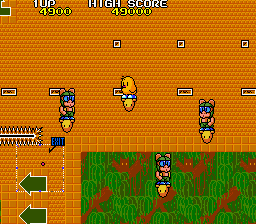
 The Game: You might think this will be the story of Captain Cook and British settlers setting in motion the fall of the indigenous Maori people of New Zealand, interpreted as a video game, but…that’s not it. It’s the story of a walrus who waltzes into the zoo and abducts every Kiwi bird there, stuffing them into a huge sack and then leaving. One Kiwi bird escapes, and you have to guide him on his quest to free all the other Kiwis. (On the other hand, perhaps it’s metaphorical somehow.) Fortunately, you happen to be the kind of Kiwi bird who can fire a bow and arrow, use a flamethrower, and can fly a little hovercraft around maze-like vertical structures. Other animals try to outfox you, gravity is against you, and your little Kiwi has only three lives. (Taito, 1988)
The Game: You might think this will be the story of Captain Cook and British settlers setting in motion the fall of the indigenous Maori people of New Zealand, interpreted as a video game, but…that’s not it. It’s the story of a walrus who waltzes into the zoo and abducts every Kiwi bird there, stuffing them into a huge sack and then leaving. One Kiwi bird escapes, and you have to guide him on his quest to free all the other Kiwis. (On the other hand, perhaps it’s metaphorical somehow.) Fortunately, you happen to be the kind of Kiwi bird who can fire a bow and arrow, use a flamethrower, and can fly a little hovercraft around maze-like vertical structures. Other animals try to outfox you, gravity is against you, and your little Kiwi has only three lives. (Taito, 1988)
Memories: This very strange little game from Taito seldom escaped from Japan until emulation and retro collections came along. Thanks to the latter, everyone can now enjoy this strangely compelling little game.
Kitten Kaboodle
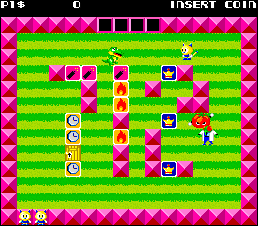 The Game: An adorable kitten (and his twin, in the case of two-player games) runs and jumps around a maze of obstacles, trying to stay out of the clutches of such enemies as an insect in a lab coat, a large and angry-looking tomato, and a crocodile that walks upright. (Further levels add new and even stranger enemies to avoid.) The kitten(s) can push the blocks making up the maze, hopefully smashing an enemy against another block or one of the playfield’s outer walls in the process, temporarily removing that enemy from play. A defeated enemy drops numerous items, including coins, diamonds, and one of several keys needed to open a door allowing access to the next level of the game. (Konami, 1988)
The Game: An adorable kitten (and his twin, in the case of two-player games) runs and jumps around a maze of obstacles, trying to stay out of the clutches of such enemies as an insect in a lab coat, a large and angry-looking tomato, and a crocodile that walks upright. (Further levels add new and even stranger enemies to avoid.) The kitten(s) can push the blocks making up the maze, hopefully smashing an enemy against another block or one of the playfield’s outer walls in the process, temporarily removing that enemy from play. A defeated enemy drops numerous items, including coins, diamonds, and one of several keys needed to open a door allowing access to the next level of the game. (Konami, 1988)
Memories: Even in the late ’80s, game companies weren’t above “borrowing” each other’s concepts and play mechanics, and here we have a prime example of Konami “borrowing” the basic play mechanic of one of Sega‘s more low-key sleeper hits, because just six years before Kitten Kaboodle, enemies were being squished by blocks pushed by a penguin.
Crazy Climber 2
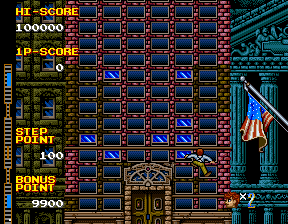 The Game: You control a daredevil stunt climber on his trip up the side of a skyscraper in a major metropolitan area, using no ropes, no nets, and nothing but his hands and his feet. Obstacles such as falling jam boxes can cause you to plunge to your death several stories below. When you reach the top – if you reach the top, that is – a helicopter lifts you away to your next challenge. (Nihon Bussan Co., Ltd. [Nichibutsu], 1988)
The Game: You control a daredevil stunt climber on his trip up the side of a skyscraper in a major metropolitan area, using no ropes, no nets, and nothing but his hands and his feet. Obstacles such as falling jam boxes can cause you to plunge to your death several stories below. When you reach the top – if you reach the top, that is – a helicopter lifts you away to your next challenge. (Nihon Bussan Co., Ltd. [Nichibutsu], 1988)
Memories: This is a bizarre, and largely graphical-only, updating of Nichibutsu’s addictive classic, Crazy Climber. The game play remains much the same as the original, but the graphics are a major evolution of what was there before. Animated flags flap in the wind, highlights and shading give Crazy Climber himself a 3-D look, and detailed billboards and neon signs glow.
Wonderboy
 The Game: Wonderboy’s girlfriend Tanya has been abducted and it’s up to you to get her back. You’ll have to be pretty crafty to avoid the dangers of Wonderland in this classic Sega platformer. (Activision, 1987)
The Game: Wonderboy’s girlfriend Tanya has been abducted and it’s up to you to get her back. You’ll have to be pretty crafty to avoid the dangers of Wonderland in this classic Sega platformer. (Activision, 1987)
Memories: Call me isolated, but for almost two decades I had no idea the classic platformer Wonderboy for the Commodore 64 was actually ported from an arcade game. While I knew the game was licensed from Sega and written by Activision, it wasn’t until just a few years ago when I happened across a Wonder Boy cartridge for the Sega Master System that I realized the game was released for multiple systems!
Defender Of The Crown
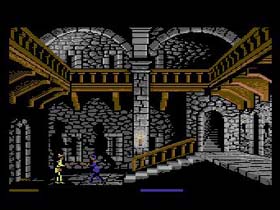 The Game: The King of England has been assassinated and the crown has gone missing! To regain the crown and restore order you’ll need to conquer the entire country, one castle at a time. Equal parts strategy and action make for lots of fun and replayability. The ultimate cinematic experience for the Commodore 64. (Cinemaware, 1987)
The Game: The King of England has been assassinated and the crown has gone missing! To regain the crown and restore order you’ll need to conquer the entire country, one castle at a time. Equal parts strategy and action make for lots of fun and replayability. The ultimate cinematic experience for the Commodore 64. (Cinemaware, 1987)
Memories: In 1986, Cinemaware released Defender Of The Crown for the Commodore Amiga, introducing a new style of game to home computer owners. Equal parts movie, strategy and action, Cinemaware called their new style of games “Interactive Movies”. Defender Of The Crown begins like a real Hollywood experience, complete with opening credits and a montage explaining the game’s backstory. The Amiga version’s graphics were literally mind-blowing. No one had seen graphics like that before on a home computer, and gamers were convinced that the game would not appear on any other platform. Commodore 64 owners got their wish one year later, when Cinemaware ported the game over to the Amiga’s 8-bit little brother.
Pole Position II
 The Game: It’s your big chance to qualify for the big race at one of four tracks: the oval test track, Seaside, Suzuka, and the Mt. Fuji track from the original Pole Position. First, you try to get through the qualifying heat, racking up laps around the track as fast you can and accumulating as few wrecks as possible. If you pass muster, then you get to try it again with other cars on the track! (Atari, 1984; released circa 1987)
The Game: It’s your big chance to qualify for the big race at one of four tracks: the oval test track, Seaside, Suzuka, and the Mt. Fuji track from the original Pole Position. First, you try to get through the qualifying heat, racking up laps around the track as fast you can and accumulating as few wrecks as possible. If you pass muster, then you get to try it again with other cars on the track! (Atari, 1984; released circa 1987)
Memories: Until the Namco Museum series came along for the Playstation, featuring true emulation of the original arcade code and graphics, this is as close as we were going to get to the finesse of an arcade Pole Position game at home – at it wasn’t too far off the mark.
Jr. Pac-Man
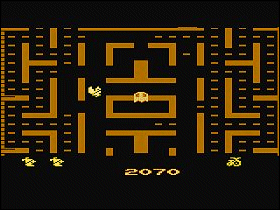 The Game: As the offspring of a round yellow creature consisting of a mouth and nothing else, you maneuver around a bigger maze than your parents ever had to deal with, gobbling small dots and evading four colorful monsters who can eat you on contact. Six large flashing dots in the maze enable you to turn the tables and eat the monsters for a brief period. Periodically, assorted toys will begin hopping through the maze, turning every uneaten dot they touch into a larger dot which yields more points, but also forces little Pac to slow down to digest them. (Atari, 1987)
The Game: As the offspring of a round yellow creature consisting of a mouth and nothing else, you maneuver around a bigger maze than your parents ever had to deal with, gobbling small dots and evading four colorful monsters who can eat you on contact. Six large flashing dots in the maze enable you to turn the tables and eat the monsters for a brief period. Periodically, assorted toys will begin hopping through the maze, turning every uneaten dot they touch into a larger dot which yields more points, but also forces little Pac to slow down to digest them. (Atari, 1987)
Memories: A few years after releasing an excellent port of Ms. Pac-Man, during the twilight of the 2600 platform, Atari visited the Pac-Man well one more time with Jr. Pac-Man, a game which rehashed the basic Pac-Man concept, only this time with a much larger, scrolling maze. Jr. Pac-Man was Atari 2600 Pac-nirvana. The graphics, the music, and the sounds were absolutely spot-on.